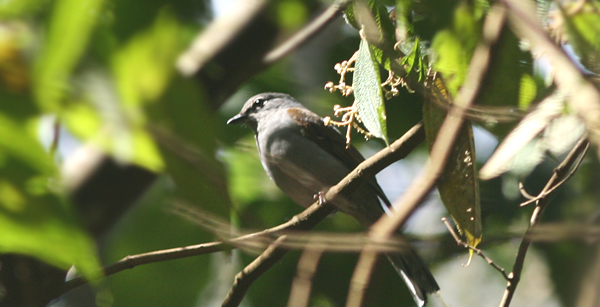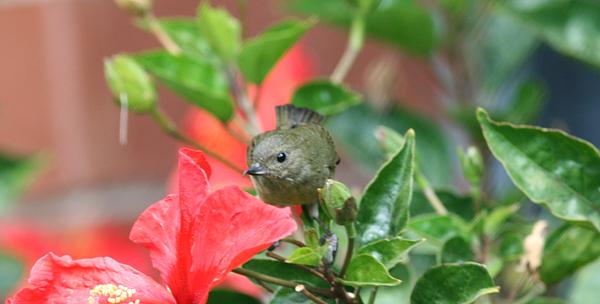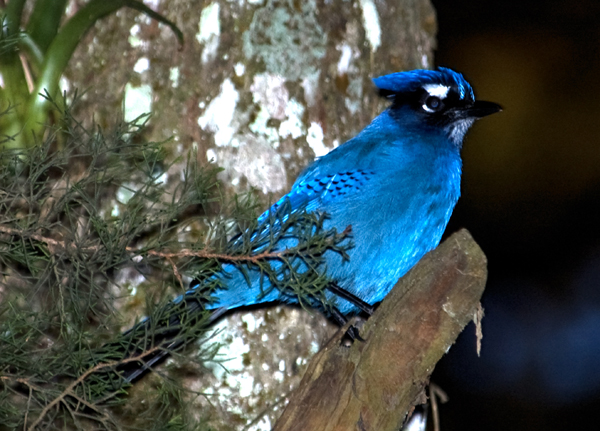So there I was, back in one of my favorite countries in the world. A few regrettable travel malfunctions kept me from attending the conference portion of the Guatemala International Birding Encounter program at Finca El Pilar so my adventure began in earnest the next morning at Cerro Alux. This was a fitting inception point as Alux was where we kicked off the festivities to great effect last year. At over 2,000 meters above sea level, this majestic montane ecosystem may be a bit cooler than a new traveler to Guatemala might expect but it is blessed with an abundance of excellent birds. Plus, its location on the road between Guatemala City and Antigua makes it an essential stop for traveling birders.
I had a few target species for Cerro Alux in mind that we didn’t encounter last time. Wouldn’t you know it, as soon as our bus stopped about 50 meters before the visitor center, we hit paydirt. A Band-tailed Pigeon flying into a bare tree drew attention to my life Rufous-browed Peppershrike. Cool name, right? It’s almost as wicked as the moniker of the next bird to pop up, the coveted Chestnut-sided Shrike Vireo. Two new birds in two minutes presaged a power-packed morning!
When I think of Cerro Alux, the birds that come to mind are Steller’s Jay and Gray Silky Flycatcher, species that were incredibly conspicuous last March. This year they seemed to give way to Brown-backed Solitaire, a thrush that utters the most ominous song I’ve ever heard. The flight call of this solitaire, a mechanical cacophony that seems to ratchet up the tension with every utterance, would be perfect for the soundtrack of a psychological thriller or horror flick. It’s also utterly apropos for a misty mountain top morning! These solitaires are incredibly elusive but, suffice to say, with that eerie song echoing through the thick pine-oak forest, they were never far from our minds.

Brown-backed Solitaire
It’s amazing how strongly memories of place persist. Last year, I explored this area in the company of Hugo Enriquez and Marco Centeno, two of the sharpest bird-spotters in Guatemala. As I walked once more with these talented field biologists, we reminisced about where certain birds turned up previously in anticipation of possible reappearances. Here was the tree in which we spotted a Spot-crowned Woodcreeper and look, there it is again. Over that ridge was where we scoped a Mountain Trogon, which sadly remained heard but not seen this year. As a cavalcade of warblers rolled through, led by throngs of Townsend’s, Wilson’s, Crescent-chested, and Slate-collared Redstart with some Black-and-White, Tennessee, Nashville, and even MacGillivray’s along for the ride, it all felt right.
Of course, in the presence of familiar birds, most of us scan the crowd for new faces. One bird notable by its absence last year was the beauteous Blue and White Mockingbird. Though as garrulous as its Northern cousin, this mimid makes eye contact a whole lot harder. We tried and tried to get great looks at a mockingbird calling from near foliage but this world-class skulker kept confounding us. At last I got lousy looks but the blue-and-white deserves much better. Next time!
As we reached a natural bower of blossoms that previously provided my life Cinnamon-bellied Flowerpiercers, a pair of these peculiar nectar sippers appeared in the process of perforating flowers. The male of this species is more boldly marked than the dun hen but the most endearing feature of either sex has to be that neat little notch on the tip of its bill.

Cinnamon-bellied Flowerpiercer
We couldn’t descend to the more open picnic area since we were visiting on a heavily-trafficked Sunday. Yet it seemed that some of the birds I had seen at the lower levels were coming up to us. For example, a chatty flock of American Bushtit in that distinctive local Black-eared plumage made the scene. So did local wrens (Band-backed and Rufous-naped) and migratory vireos (Hutton’s and Blue-headed). Tallying up the odd Green-throated Mountain Gem and Rufous-collared Robin brought our morning list to about thirty species, including some birds I’ve always been eager to meet. Coming again to Cerro Alux makes me look forward to visiting it again the next time!

Steller’s Jay by Renato Fernández Ravelo
The Steller’s Jay above was shot at Cerro Alux by Renato Fernández Ravelo, a jovial Guatemalan photographer and naturalist. Renato has published this and many other remarkable images in a gorgeous photobook titled Birds: Guatemala’s Feathers. Renato also happens to be married to Bitty Ramìrez-Portilla, one of my favorite guides in all the Neotropics. Meeting Bitty and spending time with her family outside Guatemala City last year had a profound influence on my life, one which I may one day write about. She’s really a wonderful person and one you may be fortunate enough to meet in your travels, as Bitty is the Executive Director of Specialty Tours for Guatemala Nature Tours. Power couples like Bitty and Renato prove that part of the multidimensional ecotourism allure of Guatemala is getting to know the naturalists, scientists, artists, and tour professionals that comprise the local scene.













Peppershrike is a cool name.
Great Spottings! Thanks for Publishing those pics. Just saw a steller’s jay in a similar forest at the other side of the city. And that picture was key to I’d it. Because steller’s from USA are really different at the head.